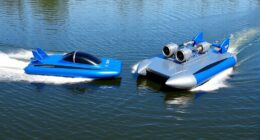To minimize marine disturbance, you can support initiatives that reduce shipping emissions and noise pollution. Choose sustainable products, advocate for low-sulfur fuels, and encourage quieter ship designs. Your choices matter—opt for local goods and support companies committed to greener maritime practices. By staying informed about the impacts of shipping on marine life, you help protect ocean health and ecosystems. Continuing to explore this issue will show you more practical ways to make a difference.
Key Takeaways
- Support regulations and initiatives that promote quieter ship designs and low-noise operation methods.
- Reduce overall shipping demand by choosing locally produced goods and minimizing unnecessary consumption.
- Advocate for the use of low-sulfur fuels and alternative propulsion technologies to lower noise and emissions.
- Encourage shipping companies and policymakers to implement speed restrictions and marine protected areas.
- Educate consumers and communities on the impacts of marine noise pollution and promote sustainable maritime practices.

Have you ever wondered how everyday actions impact the environment? It’s easy to overlook how seemingly small choices can contribute to larger ecological issues, especially when it comes to marine life. One significant concern is marine noise pollution, which results from various human activities, notably shipping emissions. When ships traverse oceans, they produce loud noises that travel vast distances underwater, disturbing marine animals that rely on sound for navigation, communication, and hunting. This constant din can disorient whales, dolphins, and other marine creatures, leading to stress, behavioral changes, and even displacement from critical habitats. Reducing marine noise pollution isn’t just about quieting the seas; it’s about protecting the health and survival of countless marine species. Additionally, implementing sustainable maritime practices can significantly decrease the negative impact on ocean ecosystems.
Shipping emissions also play a major role in environmental degradation. These emissions include carbon dioxide, sulfur oxides, nitrogen oxides, and particulate matter released from ships’ engines. They contribute to air pollution and climate change, affecting both terrestrial and marine environments. The greenhouse gases emitted by ships trap heat in the atmosphere, accelerating global warming, which then impacts ocean temperatures, sea levels, and coral reef health. Additionally, sulfur and nitrogen oxides contribute to acid rain and smog, harming coastal ecosystems and human health alike. You can see how shipping emissions are intertwined with broader climate issues, making it clear why cleaner, more sustainable maritime practices are essential.
To minimize marine disturbance, you can support initiatives aimed at reducing shipping emissions. Choosing products and companies that prioritize sustainable shipping methods can make a difference. For example, supporting businesses that advocate for low-sulfur fuels or alternative propulsion systems encourages the industry to adopt greener practices. Also, advocating for regulations that limit noise pollution, like restricting certain ship speeds in sensitive areas or implementing quieter ship designs, helps protect marine life. When ships operate more efficiently, they produce less noise and fewer emissions, which benefits the environment and local communities alike.
You can also be conscious of your own role by reducing consumption of goods that require extensive shipping. Reducing unnecessary imports or choosing products with local origins lessens demand on shipping routes. Educating others about the impacts of marine noise pollution and shipping emissions amplifies your impact, creating a ripple effect of awareness and action. Every effort counts in minimizing marine disturbance. By staying informed and making thoughtful choices, you contribute to healthier oceans and a more sustainable future. Protecting marine environments isn’t solely the responsibility of governments and industries; it begins with individual awareness and active participation.
Frequently Asked Questions
How Do Marine Disturbances Affect Local Fisheries?
Marine disturbances can profoundly impact your local fisheries by disrupting fish habitats and migration patterns. These disruptions lead to decreased fish populations, making fisheries management more challenging. As a result, maintaining fish stock sustainability becomes harder, risking overfishing and economic decline for those relying on these resources. To protect your fisheries, it’s essential to implement measures that minimize marine disturbances, ensuring healthy ecosystems and sustainable fish populations for the future.
What Are the Long-Term Impacts of Noise Pollution on Marine Life?
You might think noise pollution only causes temporary discomfort, but research suggests it leads to long-term impacts like behavioral changes and reproductive disruption in marine life. These disturbances can impair communication, navigation, and feeding, ultimately threatening species survival. While some studies confirm these effects, ongoing research explores how persistent noise could alter ecosystems, emphasizing the need to mitigate noise pollution to protect marine biodiversity and ensure the health of ocean environments.
Are There Specific Regions More Vulnerable to Marine Disturbances?
You should know that some regions are more vulnerable to marine disturbances, especially coral-rich areas near shipping lanes and oil exploration sites. These zones often face threats like oil spills and increased noise pollution, which can cause coral bleaching and disrupt marine ecosystems. If you’re involved in marine activities, it’s essential to prioritize protective measures in these sensitive regions to reduce long-term damage and preserve marine biodiversity.
How Can Tourists Help Minimize Their Environmental Impact at Sea?
To truly tackle the current question, you should practice responsible tourism and embrace eco-friendly practices. By opting for eco-conscious choices, you reduce your ripple of impact on marine life. Support sustainable tours, avoid touching or disturbing wildlife, and dispose of trash thoughtfully. Your mindful movements make a meaningful difference, helping to minimize marine disturbance and protect fragile ecosystems for future generations. Small steps can spark significant, sustainable change.
What Technologies Are Being Developed to Monitor Marine Disturbance?
Researchers are developing advanced technologies like marine sensors and acoustic monitoring to track human activities and natural events affecting marine life. These tools allow you to detect disturbances early, helping to protect ecosystems. By using real-time data from marine sensors, authorities can respond quickly to minimize impact. Acoustic monitoring offers detailed insights into underwater noise levels, enabling better regulation of boat traffic and activities that may disturb marine habitats.
Conclusion
Imagine the ocean as a delicate web, every strand essential to its strength. When you minimize marine disturbance, you’re like a careful weaver, preserving this intricate balance. For example, reducing boat noise has been shown to help marine life communicate and thrive. Every small action matters—think of it as patching tiny tears in that web. By respecting these waters, you help keep the ocean’s harmony intact for generations to come.










